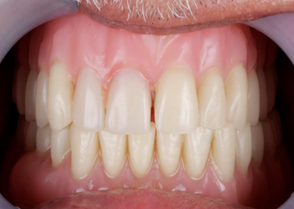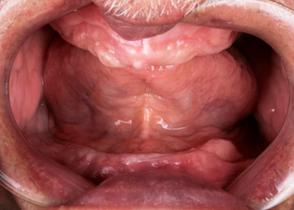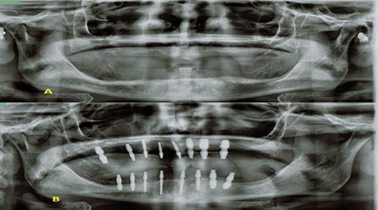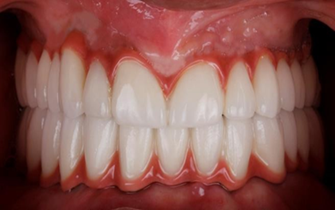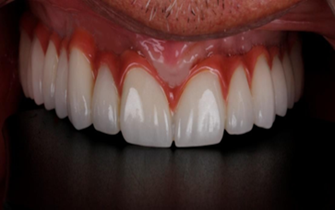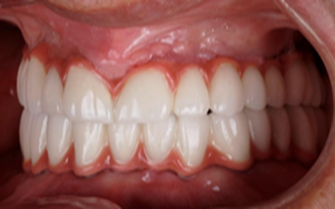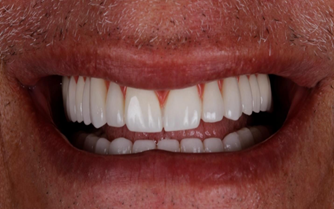Case Report
The Shift from Removable Dentures to Fixed Implant Dental Prosthesis in Complete Edentulous Diabetic 2 Patients: A Case Report
1Dean Facultyof Dentistry at 21 SeptemberUniversity, Yemen, Professor of Restorative and EstheticDentistry, Dental Implant Consultant, Faculty of Dentistry, Sana’a University, Sana’a, Yemen.
2Professor, Abdulwahab Al-kholani Dental Center,Sana’a, Yemen.
3Professor, Abdulwahab Al-kholani Dental Center,Sana’a, Yemen.
*Corresponding Author: Abdulwahab I. Al-kholani, Dean Faculty of Dentistry at 21 September University, Yemen, Professor of Restorative and Esthetic Dentistry, Dental Implant Consultant, Faculty of Dentistry, Sana’a University, Sana’a, Yemen.
Citation: Al-kholani A.I., Shamlan S.M., Al-kholani A.A. (2023). The Shift from Removable Dentures to Fixed Implant Dental Prosthesis in Complete Edentulous Diabetic 2 Patients: A Case Report. Journal of BioMed Research and Reports, BioRes Scientia Publishers. 4(6):1-5. DOI: 10.59657/2837-4681.brs.24.083
Copyright: © 2024 Abdulwahab I. Al-kholani, this is an open-access article distributed under the terms of the Creative Commons Attribution License, which permits unrestricted use, distribution, and reproduction in any medium, provided the original author and source are credited.
Received: April 24, 2024 | Accepted: May 08, 2024 | Published: May 15, 2024
Abstract
This report aims to shift from removable complete dentures to fixed prosthodontics with the help of one-piece immediate loading dental implants among type 2 diabetic patients to reach full patient satisfaction, considering the functional and esthetic aspects. There are three types of diabetes mellitus: Type 1 (insulin-dependent), Type 2 (non-insulin-dependent), and gestational. Flapless implant surgery is fast gaining popularity because of several advantages, such as reduced surgical time, postoperative bleeding, and swelling. There is a shortage of data available concerning the clinical outcomes involving the use of implant treatment for patients with diabetes mellitus. In this report, the patient had been wearing a complete denture in the upper and lower jaws for several years, and he believed that it was not possible to get dental implants because he was suffering from type-2 diabetes. It was explained to the patient that studies are promising that it is possible to successfully perform dental implants in cases similar to his condition. The patient agreed and the dental implant took place, and after two years the results were considered excellent, and the case was monitored regularly.
Keywords: one-piece dental implant; flapless technique; complete edentulous; immediate loading; patient satisfaction; diabetic patient
Introduction
It is well understood that many patients who wear complete dentures usually experience considerable difficulty in adapting to their removable prostheses. In contrast, a few patients may be adaptive for several years but become maladaptive later as a result of tissue changes. Some patients absolutely cannot wear dentures at all, and their quality of life is greatly affected by their dilemma. Clinical experience and some researches have confirmed that there are physiological as well as psychological contributions to maladaptation [1]. The need to replace missing teeth with successful results has motivated rapid research and innovation in the field of dental implants. Currently, dental implants are widely used as a prosthetic treatment for completely or partially edentulous patients [2]. Fixed prosthodontics placed over dental implants have a better psychological impact on patients with complete tooth loss because they increase patient satisfaction and quality of life more than traditional complete dentures or leave the patients without satisfactory solutions [3].
Case Report
A 77-year-old male patient reported to a private Dental Center with a completely edentulous case Figure 1. He has full dentures in the maxilla and the mandible with poor stability during function Figure 2. The patient's psychological condition was poor. The functional status during mastication of food and speaking was not comfortable due to the lack of stability of the complete dentures. Clinical and laboratory investigations revealed that the patient is classified as a type-2 diabetic patient. The radiographic examination Figure-3 showed the presence of sufficient bone in terms of width and height, and it is suitable for dental implants. Prosthodontic treatment of the edentulous patient is challenging because it usually requires a complete rehabilitation of oral structures and facial morphology. Treatment planning is the first and most important step in clinical implantology. Surgical procedures and laboratory prosthodontics must be considered. The ideal placement of the implants in the bone should not interfere with the esthetics and correct design of the prosthesis. Intraoral and extraoral diagnosis follows an evaluation of old dentures regarding the vertical dimension of occlusion, function, and esthetics. The patient was successfully retreated by insertion of 16 one-piece dental implants (8 dental implants in each jaw) using a flapless technique Figure-4 followed by the placement of fixed prosthodontics for the upper and lower jaws. After two years of follow-up overall satisfaction, chewing, and speaking comfort were all markedly improved from pre-treatment. Diabetes mellitus is no longer considered to be a contraindication for implant-supported prostheses, provided that the patient’s blood sugar is under control and that there is a motivation for oral hygiene procedures [4].
Figure 1: Intra-oral view with complete upper and lower dentures in place.
Figure 2: Intra-oral view showing completely edentulous jaws.
Figure 3: Digital panoramic radiograph (A) before dental implant placement, (B) after dental implant placement.
Figure 4: One-piece dental implants in place using a flapless technique.
Definitive restoration
For the definitive restoration fabrication, the following steps were followed. Intra-oral scanning for upper and lower arches after implant placement. Maxillary and Mandibular silicone impressions were taken. Jaw relation recording and bite registration were done digitally, and conventionally. An esthetic mock-up was performed on the existing provisional bridges and recorded. Try-in of the zirconium bridges was done and, shade selection was checked, occlusion was adjusted to implant-protected occlusion. At delivery, it was ensured that the final prosthesis was fitted with perfect retention and stability. Temporary fixation for prosthesis was carried out to allow the patient to test the restoration and ask him to come back after 2 days with recording any comments if any. In the final visit permanent fixation of the fixed restoration was performed, and the Patient was motivated and instructed to keep good oral Hygiene Figures-5-9. Patient was advised to come back after 3 months, then every year for regular check-ups.
Figure 5: Intra-oral frontal view showing the final restoration.
Figure 6: Intra-oral view of an upper jaw with the final restoration.
Figure 7: Intra-oral right view with the final restoration.
Figure 8: Intra-oral left view with the final restoration.
Figure 9: Intraoral left view while smiling.
Discussion
Despite evidence-based research has reported that dental implants among diabetic patients showed an increasing trend of implant failure during the period of osseointegration and the first year of loading, this study provides supporting evidence to Mostafa et al [3]; that type II diabetes may not be an absolute risk factor for immediate loading protocols and that dental implants are safe and predictable procedures for dental rehabilitation in type 2 diabetic patient [5]. Dental implants enable undisturbed healing of the one-piece tissue compared to the two-piece design [6]. Due to the absence of the connecting screw, it is possible to give a one-piece implant of smaller diameter so that it can be used in narrow edentulous areas. A one-piece implant design with a built-in abutment can be prepared with a tungsten carbide bur using the same principles for tooth preparation. Also, the impression procedures that are used for one-piece implant design are similar to that of a prepared tooth [7]. Periodic clinical assessment of the dental implant, prosthesis, and surrounding tissue is critical for clinical success. In the present case, the patient was called every 3, 6, and 12 months [8]. After two years, the results were excellent, there were no complications and the patient was highly satisfied. Future research and clinical trials over a longer period are required to determine the long-term survival of implants in different groups of patients with diabetes mellitus. Concerning this case report, to obtain sufficient information the case must be followed for 3-5 years.
Conclusion
The flapless surgery with one-piece dental implant treatment and fixed restoration concept is a straightforward and predictable treatment option to rehabilitate complete edentulous patients with improved functional and patient satisfaction. Within the limitations of this study, it can be concluded that flapless implant surgery results in lesser loss of interproximal bone and also results in better papillary fill when compared with the flap technique. Proper patient selection is essential for carrying out flapless implant surgery [9].
References
- Hye-sung Kim, Han-A Cho, Young-youn Kim, Hosung Shin. (2018). Implant survival and patient satisfaction in completely edentulous patients with immediate placement of implants: a retrospective study. BMC Oral Health, 18(1).
Publisher | Google Scholor - A Satpathy, A Porwal, A. Bhattacharya, PK Sahu. (2011). Patient awareness, acceptance and perceived cost of dental Implants as a treatment modality for replacement of missing teeth: A survey in Bhubaneswar and Cuttack. Int J Public Health Dent.
Publisher | Google Scholor - Mostafa, Tamer MN, Hesham S. Borg, and Ahmed M. Alam-Eldein. (2021). Immediately loaded implant retained mandibular overdenture in controlled diabetic patients: results of 5 years prospective clinical study. Tanta Dental Journal, 18(4):114.
Publisher | Google Scholor - Abdulwassie, Hassan, and P. J. (2002). Dhanrajani. Diabetes mellitus and dental implants: a clinical study. Implant dentistry 11(1):83-86.
Publisher | Google Scholor - Naujokat H, Kunzendorf B, Wiltfang J. (2016). Dental implants and diabetes mellitus‑a systematic review. Int J Implant Dent, 2:5-14.
Publisher | Google Scholor - Sunil M, Reddy BM, Reddy TS, Reddy NR. (2013). Full mouth rehabilitation with fixed implant- supported prosthesis: A case report. J NTR Univ Health Sci, 2:292-295.
Publisher | Google Scholor - Froum Stuart J. (2011). Survival rate of one piece dental implantsplaced with flapless or flap protocol – A Randomized, controlled study; 12 months results. Int J Periodont Dent, 31:591-601.
Publisher | Google Scholor - Aravind, Prasad, et al. Full mouth rehabilitation with one piece implants–A case report.
Publisher | Google Scholor - Sunitha, Raja V., and Enukurthi Sapthagiri. (2013). Flapless implant surgery: a 2-year follow-up study of 40 implants. Oral surgery, oral medicine, oral pathology and oral radiology 116(4):e237-e243.
Publisher | Google Scholor

